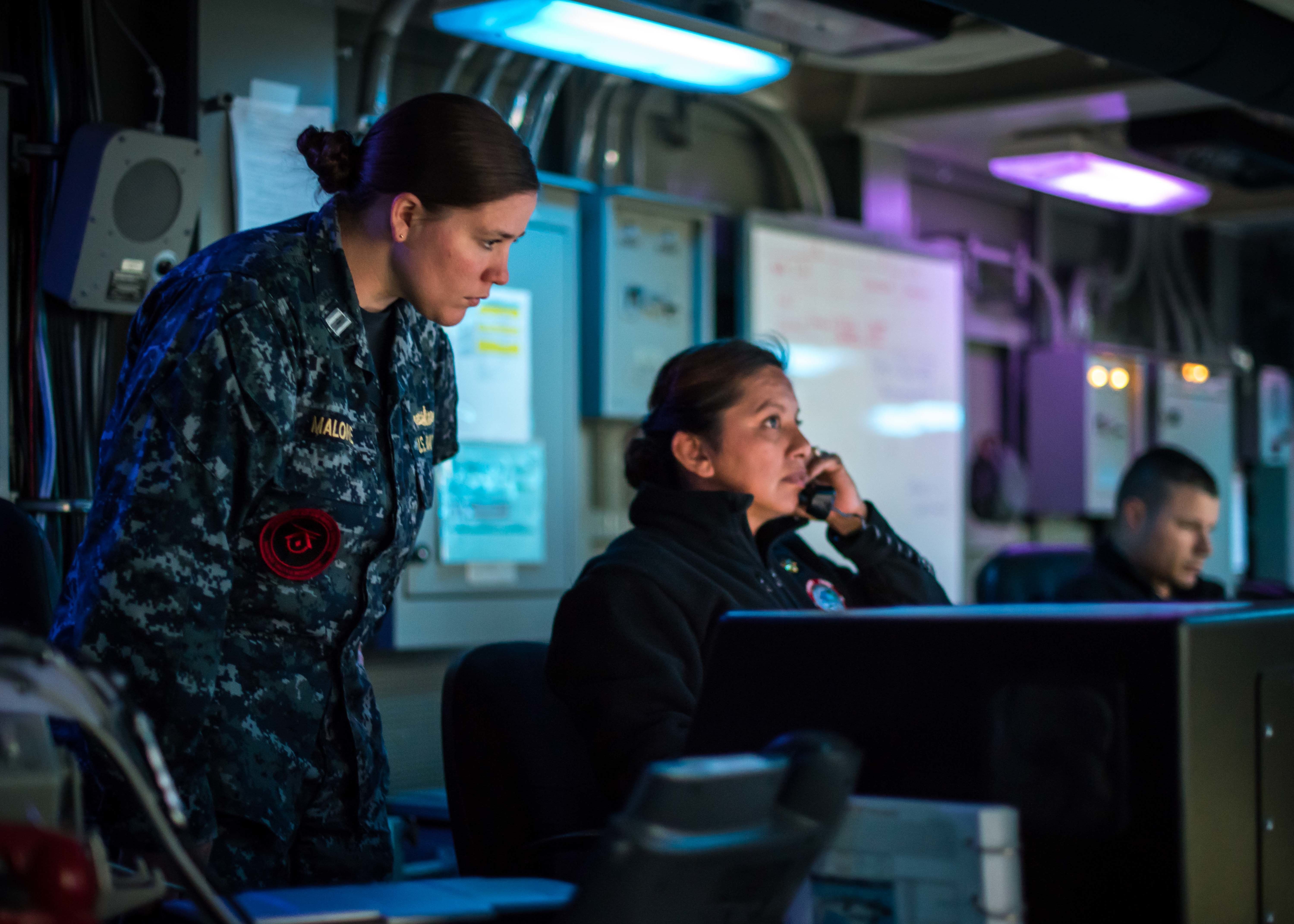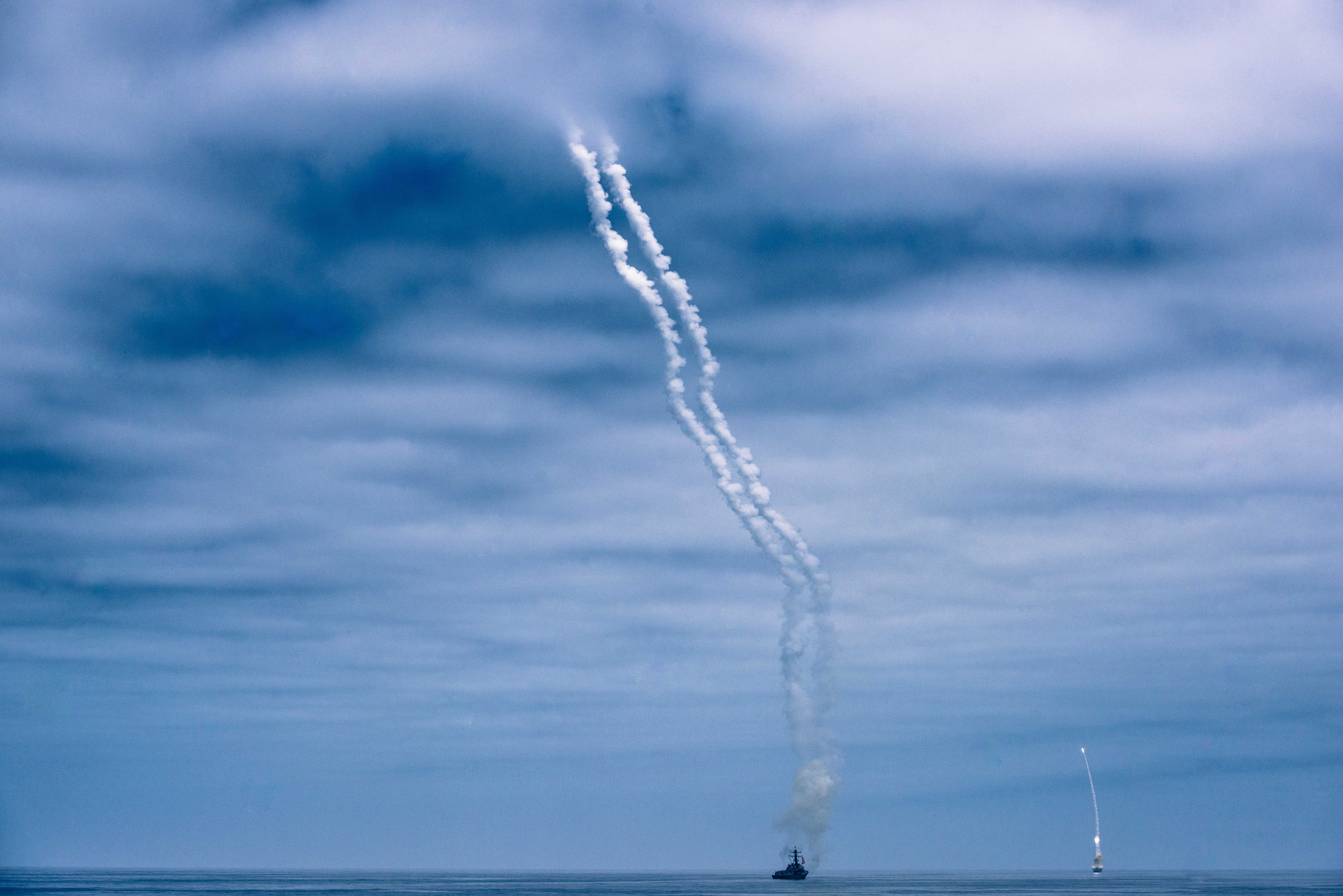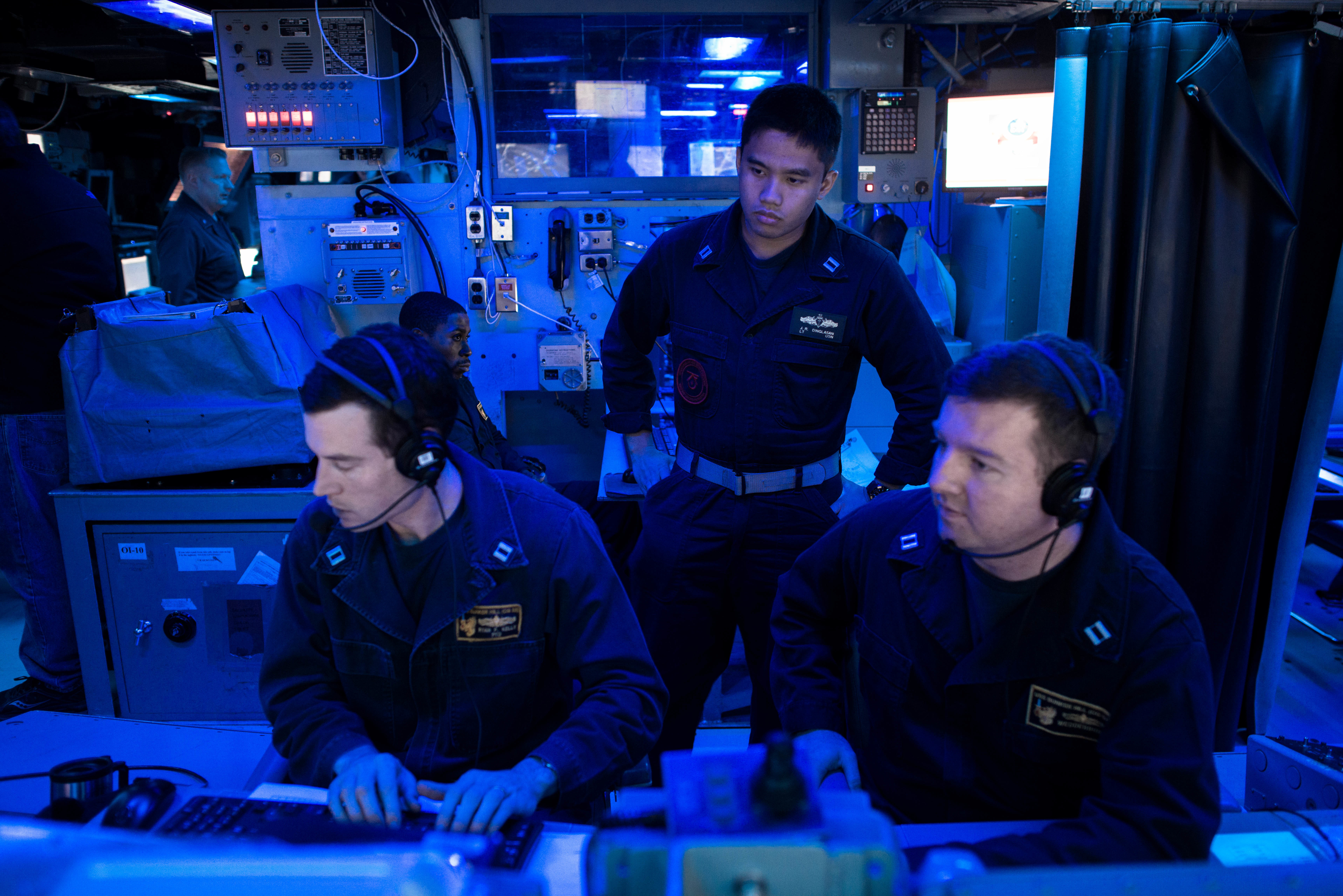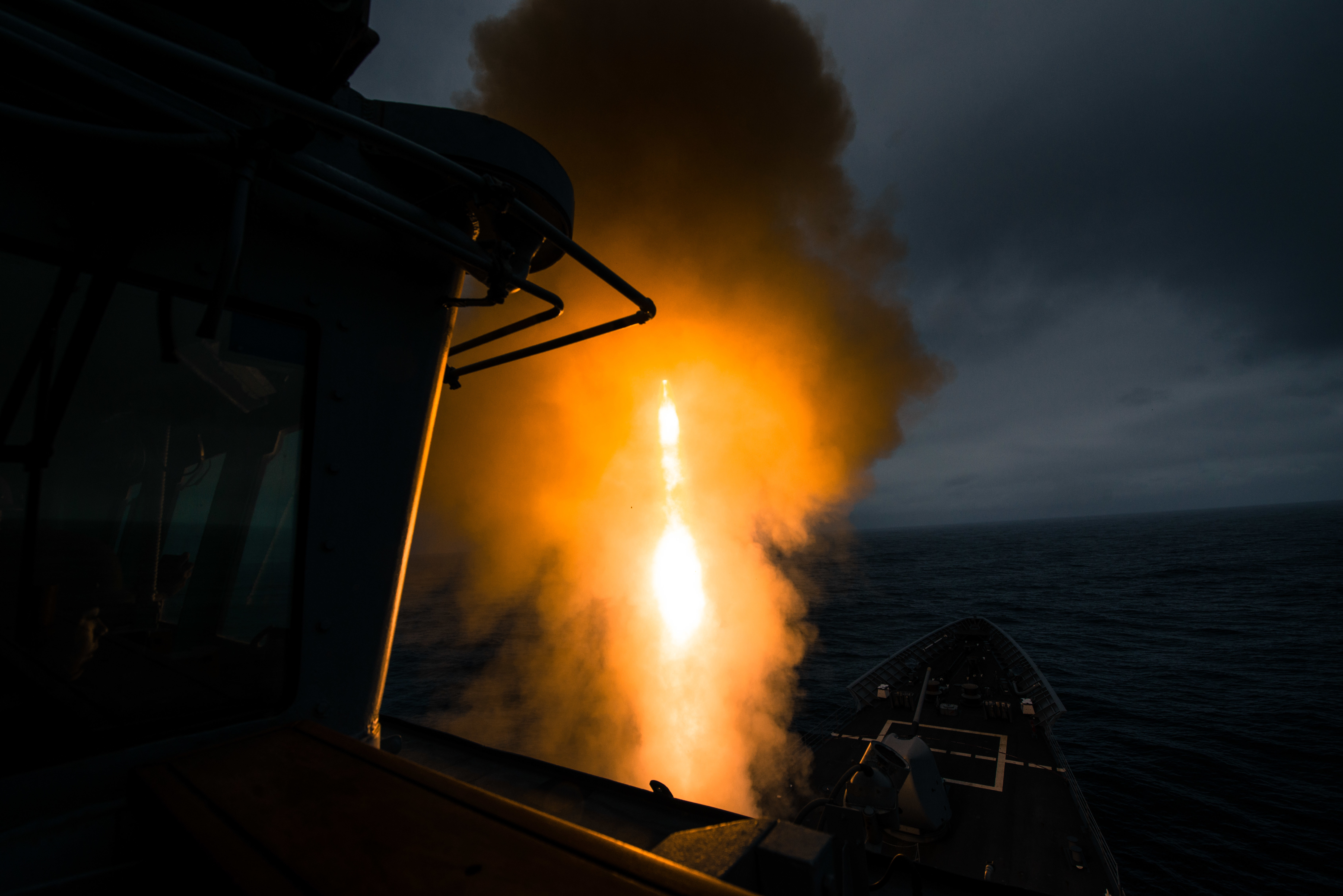
ABOARD USS BUNKER HILL AND USS THEODORE ROOSEVELT – Three years after the conception of the Naval Surface and Mine Warfighting Development Center, the Warfare Tactics Instructors that have come out of SMWDC are making a tangible difference in how surface ships conduct their missions, leadership from the Theodore Roosevelt Carrier Strike Group told USNI News.
Self-described as the Top Gun for surface warfare officers, SMWDC (pronounced smi-dik) trains classes of WTIs in multiple warfare areas, uses them to conduct high-end training events with deploying ships and strike groups, and then sends them on to their next assignment to spread their surface warfare expertise with their next unit.
The TR Strike Group, which USNI News visited at the end of its deployment to U.S. 5th Fleet and is now in U.S. 7th Fleet on its way home, has multiple WTIs throughout the strike group’s ships, including Chief Warrant Officer 3 Troy Woods, the systems test officer on cruiser USS Bunker Hill (CG-52) and an integrated air and missile defense (IAMD) WTI.
Bunker Hill Commanding Officer Capt. Joe Cahill told USNI News that the Navy clearly recognizes it is in a great power competition, and that investing in expertise among its officers is a critical part of succeeding in this environment.
“We are investing in officer expertise. And that’s something that, when I was growing up as a young surface warfare officer, we didn’t,” he said.
“But this is a deliberate investment in expertise that we’re making in guys like Troy, and I think it’s going to enable us, from a deterrence perspective – because what we have to be able to do in this great power competition that we’re now in is we have to be able to convince the other side that, should they choose to move first, that they will not be able to meet their goals. And they know that we’re now investing in this expertise.”

Cahill, who was among a small handful of officers tasked with standing up SMWDC in 2015, said the organization and the surface Navy are both benefiting from a regular dialogue. Every year SMWDC invites back all the WTIs that have graduated from the program for a “rebluing” refresher course. Cahill sent Woods to the event in January even though it was in the middle of the deployment, and both said it was well worth the effort.
Woods told USNI News that about 55 of the 100 or so IAMD WTIs were in attendance, and he had about 30 minutes to address the group on what he had seen during the deployment.
“The theories that we talked about (at SMWDC), those tactics – I’m like, we’re doing this, this works, this didn’t, we’re actually planning this out, this is how this actually works, this is how we’re actually configuring our radar,” he said, which helps finesse how SMWDC looks at best practices. The continued interactions go both ways, Woods said, noting that “we even had some of the guys writing [tactical memos] recently come out here to actually test out some of their theories before they publish the tac memo. I would say that theories are great, I love sitting in a room coming up with awesome ideas; but when you come out here and actually put it into practice, that key element has to take place.”
The topics that SMWDC tackles in its tactical memos and other work are partly driven by their assessments of the threat environment and partly driven by fleet needs. For example, TR Strike Group’s Destroyer Squadron 23 Commodore Capt. Bill Daly told USNI News that he was concerned going into the Middle East deployment that, because his destroyers would be disaggregated most of the time, they might lose some proficiency in high-stakes aggregated operations like strait transits.
About a year ahead of the deployment, he brought that concern to SMWDC, which developed a “concentrating at sea” set of best practices that it now teaches deploying strike groups, which is “now being used by 5th Fleet as a standard.”
“I had never seen that level of rigor and repeated attempts in order to build that proficiency in executing it,” Daly said of the DESRON’s work with SMWDC on the strait transits ahead of deploying. He said he learned that skill in a previous deployment, but he said the fleet is now gaining a “deep mastery” of it instead of a passing ability to conduct strait transits and at-sea aggregations.
Overall, Daly said, “I think we are much more savvy with respect to sea control, with respect to the rigor of what we’re doing. … Between the warfare development commands that have been stood up, we’re better at what we do.”

The strike group also benefitted from some technology SMWDC is investing in, both for training events but also to help ships learn lessons from their deployed operations. Bunker Hill was outfitted with a Simulated Display, or SimDis, capability just prior to deploying. This prototype system, similar to something aviators already use, records all raw radar data so that after training activities or some real-world event operators can look back at what actually happened and try to learn from it.
“It’s like DNA evidence, and we in the surface community never had it before, so it’s a huge piece from our planning standpoint,” Cahill said, noting that the SimDis helps each of his watch teams go through their daily plan, brief, execute and debrief (PBED) process, as well as to brief the strike group commander if there’s any discrepancy between how the ships in the group perceived any event.
“It’s provided tremendous value. I think we learn quicker now as a team than I’ve ever experienced before.”
Cahill said eventually all surface ships would get the SimDis capability but that SMWDC was investing in the air warfare commander ships, or Whiskeys, first.

Though SMWDC has already proven itself a valuable organization for developing standard practices and tactics, training the fleet, creating and scattering out warfare area experts and facilitating new ways of leveraging expertise, Cahill said, SMWDC and the surface navy cannot declare success and relax.
“What we saw during the ‘50s and the ‘60s and part of the early ‘70s is, you can’t look in the wake. Even though we’ve done a lot of great things with SMWDC, we’ve made a lot of great inroads from a ‘steam, drive, fight’ perspective, it is a competition. I would argue that the successes we have as a community and as a naval task force, we have to continue because it is a great power competition, and the competition is adjusting,” Cahill said.
“So the key to our success as a Navy for the nation is, can we continue to adjust and can we continue to learn faster? And we have to be able to, and I think we are and it’s been the strength of our nation, is that ability to adapt quickly. … That’s what we have to do, and we can’t rest.”





